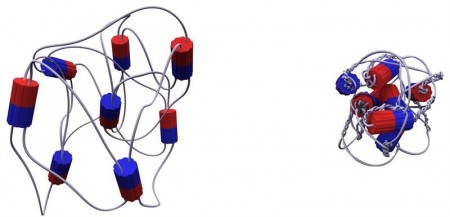Jan
22
A Plastic Muscle Powered By Light That Is A Battery Too
January 22, 2015 | 1 Comment
Researchers at the Institut Charles Sadron, University of Strasbourg in France have made a polymer gel that is able to contract through the action of artificial molecular motors. The effect is similar to the linear motion of a muscle contraction. This might be the first artificial muscle.

Schematic representation of a polymer gel whose chains are cross-linked using rotating molecular motors (the red and blue parts of the motor can turn relative to each other when provided with energy). Right: When exposed to light, the motors start to rotate, twisting the polymer chains and contracting the gel by as much as 80% of its initial volume: in this way, part of the light energy is stored as mechanical energy. Image Credit: © Gad Fuks / Nicolas Giuseppone / Mathieu, Lejeune. Institut Charles Sadron. Click image for the largest view.
When activated by light, these motors twist the nanoscale polymer chains in the gel that as a result contract by several centimeters.
Plus, the new material is able to store the light energy it absorbed.
The team’s paper has been published in Nature Nanotechnology.
In a living organism individual muscle cells make structural motion that has an effect at the macroscale, such as a muscle that contracts via the concerted action of the combine cellular protein motors.
In order to reproduce this phenomenon, a team at CNRS’s Institut Charles Sadron led by Nicolas Giuseppone, professor at the Université de Strasbourg, has made a polymer gel that is able to contract through the action of artificial molecular motors. When activated by light, these nanoscale motors twist the polymer chains in the gel, which as a result contracts by several centimeters.
In life forms molecular motors are highly complex protein assemblies that can produce work by consuming energy. They take part in fundamental biological functions such as copying DNA and protein synthesis at the smallest scale, and underlie all motion processes in the large scale. As individual cells, the motors only operate over distances in the region of a nanometer. But when millions of them join up they can work in a completely coordinated way, and their actions have an effects at the macroscale.
Chemists have sought for many decades to produce this type of motion using artificial motors. To achieve this, the researchers at Institut Charles Sadron replaced the gel’s reticulation points, which cross-link the polymer chains to each other, by rotating molecular motors made up of two parts that can turn relative to each other when provided with energy.
For the first time, they succeeded in getting the motors to work in a coordinated and continuous manner, right up to the macroscale: as soon as the motors are activated by light they twist the polymer chains in the gel, which makes it contract.
Just as in living systems, the motors consume energy in order to produce continuous motion. But the light energy is not totally dissipated. It is turned into mechanical energy through the twisting of the polymer chains, and stored in the gel.
If the material is exposed to light for a long time, the amount of energy contained in the contraction of the polymer chains becomes very high, and can even trigger a sudden rupture of the gel.
The researchers at Institut Charles Sadron are therefore now attempting to take advantage of this new way of storing light energy, and reuse it in a controlled manner.
Its a good start. Perhaps there will be enough insight here to discover how to power and store with electrons someday. For now its quite an accomplishment. The possibilities are amazing.
Comments
1 Comment so far


I feel that by cross-linking the polymer chains to each other and by rotating molecular motors made up of two parts, it can turn relative to each other when provided with energy.